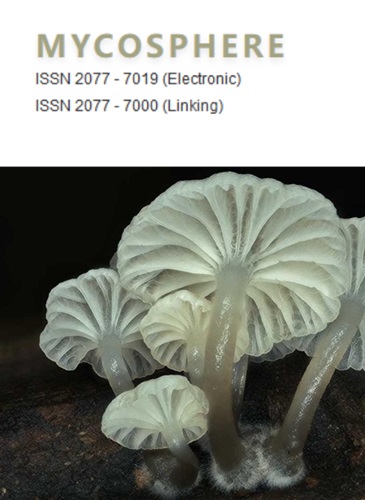模式种的测序结果表明,铁锥虫科是铁锥虫科的同义种
IF 15.1
1区 生物学
Q1 MYCOLOGY
引用次数: 3
摘要
棘皮虫包括地衣、地衣化和非地衣化腐养物种;然而,一些分类群的生活方式是地衣化的还是腐养的尚不清楚。迄今为止,该属的系统位置尚未确定:虽然已测序的物种出现在dothideomycates的不同分支中,但模式种A. cerasi迄今没有分子数据。代替序列数据,将arthropyreniaceae归属于Pleosporales,而将热带地衣化的物种重新划分为缢虫门和大缢虫门,显示其属于trypethelae (Trypetheliales)。在本研究中,首次对属型A. cerasi进行了测序。利用mtSSU和nuLSU序列进行的最大似然和贝叶斯系统发育分析显示,严格意义上的arthropyrenia是trypethelaceae中的一个早期分化谱系,与缢虫门和大缢虫门分开,但与温带、非地衣化的fallacosa属同一进化支。因此,本文将石竹属植物同义归入石竹属植物,并根据形态学和系统发育的证据对其模式种的分类定位进行了讨论。我们的系统发育结果进一步支持Mycosphere 12(1): 993-1011 (2021) www.mycosphere.org ISSN 2077 7019本文章由计算机程序翻译,如有差异,请以英文原文为准。
Sequencing of the type species of Arthopyrenia places Arthopyreniaceae as a synonym of Trypetheliaceae
Arthopyrenia sensu lato comprises lichenicolous, lichenized and non-lichenized saprotrophic species; however, the lifestyle of several taxa as either lichenized or saprotrophic remains unclear. The systematic position of the genus was so far unresolved: while sequenced species appeared in different clades within Dothideomycetes, the type species, A. cerasi, had no molecular data so far. In lieu of sequence data, the family Arthopyreniaceae was assigned to Pleosporales, whereas tropical, lichenized species were reclassified in Constrictolumina and Macroconstrictolumina, shown to belong in Trypetheliaceae (Trypetheliales). In this study, the generic type, A. cerasi, has been sequenced for the first time. Maximum likelihood and Bayesian phylogenetic analyses using mtSSU and nuLSU sequences recovered Arthopyrenia sensu stricto as an early diverging lineage within Trypetheliaceae, separate from Constrictolumina and Macroconstrictolumina but in the same clade as the temperate, non-lichenized Julella fallaciosa. Therefore, Arthopyreniaceae is here synonymized under Trypetheliaceae and the taxonomic placement of its type species is discussed based on morphological and phylogenetic evidence. Our phylogenetic results further support the Mycosphere 12(1): 993–1011 (2021) www.mycosphere.org ISSN 2077 7019
求助全文
通过发布文献求助,成功后即可免费获取论文全文。
去求助
来源期刊

Mycosphere
MYCOLOGY-
CiteScore
30.00
自引率
8.20%
发文量
9
审稿时长
4 weeks
期刊介绍:
Mycosphere stands as an international, peer-reviewed journal committed to the rapid dissemination of high-quality papers on fungal biology. Embracing an open-access approach, Mycosphere serves as a dedicated platform for the mycology community, ensuring swift publication of their valuable contributions. All submitted manuscripts undergo a thorough peer-review process before acceptance, with authors retaining copyright.
Key highlights of Mycosphere's publication include:
- Peer-reviewed manuscripts and monographs
- Open access, fostering accessibility and dissemination of knowledge
- Swift turnaround, facilitating timely sharing of research findings
- For information regarding open access charges, refer to the instructions for authors
- Special volumes, offering a platform for thematic collections and focused contributions.
Mycosphere is dedicated to promoting the accessibility and advancement of fungal biology through its inclusive and efficient publishing process.
 求助内容:
求助内容: 应助结果提醒方式:
应助结果提醒方式:


